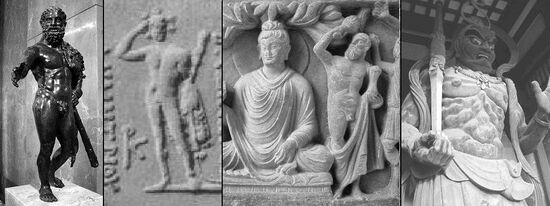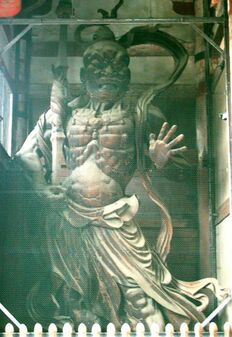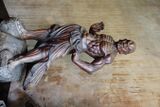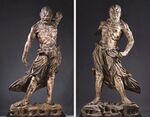Religion:Nio
Niō (仁王) are two wrathful and muscular guardians of the Buddha standing today at the entrance of many Buddhist temples in East Asian Buddhism in the form of frightening wrestler-like statues. They are dharmapala manifestations of the bodhisattva Vajrapāṇi, the oldest and most powerful[citation needed] of the Mahayana Buddhist pantheon. According to scriptures like the Pāli Canon as well as the Ambaṭṭha Sutta, they travelled with Gautama Buddha to protect him. Within the generally pacifist tradition of Buddhism, stories of dharmapalas justified the use of physical force to protect cherished values and beliefs against evil. They are also seen as a manifestation of Mahasthamaprapta, the bodhisattva of power that flanks Amitābha in Pure Land Buddhism and as Vajrasattva in Tibetan Buddhism.[1]
Manifestations
Symbolic meaning
They are usually portrayed as a pair of figures that stand guarding temple entrance gates usually called Shānmén (山門) in China, Niōmon (仁王門) in Japan and Geumgangmun (金剛門) in Korea. The right statue is traditionally called Guhyapāda and has his mouth open, representing the vocalization of the first grapheme of Sanskrit Devanāgarī (अ) which is pronounced "a".[2] The left statue is traditionally called Nārāyaṇa and has his mouth closed, representing the vocalization of the last grapheme of Devanāgarī (ह [ɦ]) which is pronounced "Script error: The function "transl" does not exist." (हूँ). These two characters together (a-hūṃ/a-un) symbolize the birth and death of all things. (Men are supposedly born speaking the "a" sound with mouths open and die speaking an "Script error: The function "transl" does not exist." and mouths closed.) Similar to Jaya-Vijaya, they signify "everything" or "all creation". The contraction of both is Aum (ॐ).
Guhyapāda
Guhyapāda (Traditional Chinese: 密迹金剛; simplified Chinese: 密迹金刚; pinyin: Mìjī jīngāng; Japanese: Misshaku Kongō; Korean: Miljeok geumgang; Vietnamese: Mật tích kim cương ) is a symbol of overt violence: he wields a vajra mallet "Script error: The function "transl" does not exist." (a diamond club, thunderbolt stick, or sun symbol)[3] and bares his teeth. His mouth is depicted as being in the shape necessary to form the "ha" or "ah" sound. In China, he is also known as General Ha (哈将 Hā Jiāng) in reference to this iconographic detail. Similarly, he is also known as Agyō (阿形, "a"-form, general term open-mouthed statues in aum pair) in Japan due to this detail as well. In Chinese Buddhism, Guhyapāda is regarded as one of the Twenty-Four Protective Deities, who are a grouping of dharmapalas often enshrined in the Mahavira Hall of temples and monasteries. In addition, Guhyapada is also sometimes paired or identified with the Wisdom King Ucchuṣma, who is commonly known in Chinese as Huìjì Jīngāng (穢跡金剛).[4]
Nārāyaṇa
Nārāyaṇa (Traditional Chinese: 那羅延金剛; simplified Chinese: 那罗延金刚; pinyin: Nàluōyán Jīngāng; Japanese: Naraen Kongō; Korean: Narayeon geumgang; Vietnamese: Na la diên kim cương) is depicted either bare-handed or wielding a sword. He symbolizes latent strength, holding his mouth tightly shut. His mouth is rendered to form the sound "Script error: The function "transl" does not exist.", or "heng" or "un". In China, he is also known as General Heng (哼将 Hēng Jiāng) in reference to this iconographic detail. Similarly, he is also known as Ungyō (吽形, "um"-form, general term closed-mouthed statues in aum pair) in Japan due to this detail as well.
Vajrapāni
Both Guhyapāda and Nārāyaṇa are seen as manifestations of Vajrapāni (Traditional Chinese: 執金剛神; simplified Chinese: 执金刚神; pinyin: Zhíjīngāng shén; Japanese: Shūkongōshin; Korean: Jip geumgang sin; Vietnamese: Chấp kim cang thần)[2], with the name literally meaning "vajra-wielding god".
Nio Zen Buddhism
Nio Zen Buddhism was a practice advocated by the Zen monk Suzuki Shōsan (1579–1655), who advocated Nio Zen Buddhism over Nyorai Zen Buddhism. He recommended that practitioners should meditate on Nio and even adopt their fierce expressions and martial stances in order to cultivate power, strength and courage when dealing with adversity.[5] Suzuki described Nio as follows: "The Niō (Vajrapani) is a menacing God. He wields the kongōsho (vajra) and he can crush your enemies. Depend on him, pray to him that he will protect you as he protects the Buddha. He vibrates with energy and spiritual power which you can absorb from him in times of need."[citation needed]
Influence on Taoism
In Chinese folk religion and Taoism, they are known as Heng Ha Er Jiang (哼哈二將). Within the Taoist novel Fengshen Yanyi, Zheng Lun and Chen Qi were finally appointed as the two deities.[6]
Hellenistic influence
Kongōrikishi are a case of the transmission of the image of the Greek hero Heracles to East Asia along the Silk Road. Heracles was used in Greco-Buddhist art to represent Vajrapani, the protector of the Buddha, and his representation was then used in China and Japan to depict the protector gods of Buddhist temples. This transmission is part of the wider Greco-Buddhist syncretic phenomenon, where Buddhism interacted with the Hellenistic culture of Central Asia from the 4th century BC to the 4th century AD.[7]

1) Heracles (Louvre Museum).
2) Heracles on coin of Greco-Bactrian king Demetrius I.
3 Vajrapani, the protector of the Buddha, depicted as Heracles in the Greco-Buddhist art of Gandhara.
4) Shukongōshin of Buddhist temples in Japan.(Sensō-ji)
Gallery
Narayeon Geumgang at Hwa-Eom Temple in South Korea
See also
- Buddhist and Greco-Buddhist art
- List of Buddhist architecture in China
- Buddhist temples in Japan
- Door gods, for similar protective East Asian deities
- Heng and Ha
- Greco-Buddhism
- Jaya-Vijaya
- Korean Buddhism
- Vajrapani and Skanda
- Om
- Ox-Head and Horse-Face
- Lugal-irra and Meslamta-ea
- Castor and Pollux
- Alexiares and Anicetus, twin-sons of Heracles/Hercules and Hebe/Juventas; alongside their father, they are the guardians of the gates of Mount Olympus.
- Janus
Notes
- ↑ The illustrated encyclopedia of Zen Buddhism By Helen Josephine Baroni, Page 240
- ↑ 2.0 2.1 Transliterations from Digital Dictionary of Buddhism
- ↑ See "金剛" at William Edward Soothill and Lewis Hodous. A Dictionary of Chinese Buddhist Terms
- ↑ Zhaohua., Yang (2013). Devouring impurities : myth, ritual and talisman in the cult of Ucchusma in Tang China. OCLC 848167476. http://worldcat.org/oclc/848167476.
- ↑ Helen Josephine Baroni (June 2002). The illustrated encyclopedia of Zen Buddhism. The Rosen Publishing Group. p. 240. ISBN 978-0-8239-2240-6. https://books.google.com/books?id=smNM4ElP3XgC&pg=PA240. Retrieved 26 March 2012.
- ↑ Fengshen Yanyi, chapter 99.
- ↑ "The origin of the image of Vajrapani should be explained. This deity is the protector and guide of the Buddha Sakyamuni. His image was modeled after that of Hercules. (...) The Gandharan Vajrapani was transformed in Central Asia and China and afterwards transmitted to Japan, where it exerted stylistic influences on the wrestler-like statues of the Guardian Deities [Nio]." (Katsumi Tanabe, "Alexander the Great, East-West cultural contacts from Greece to Japan", p23)
References
- Religions of the Silk Road by Richard Foltz, 2nd edition (Palgrave, 2010) ISBN:9-780230-621251
- The Diffusion of Classical Art in Antiquity by John Boardman (Princeton University Press, 1994) ISBN:0-691-03680-2
- Old World Encounters. Cross-cultural contacts and exchanges in pre-modern times by Jerry H.Bentley (Oxford University Press, 1993) ISBN:0-19-507639-7
- Alexander the Great: East-West Cultural contacts from Greece to Japan (NHK and Tokyo National Museum, 2003)
External links













